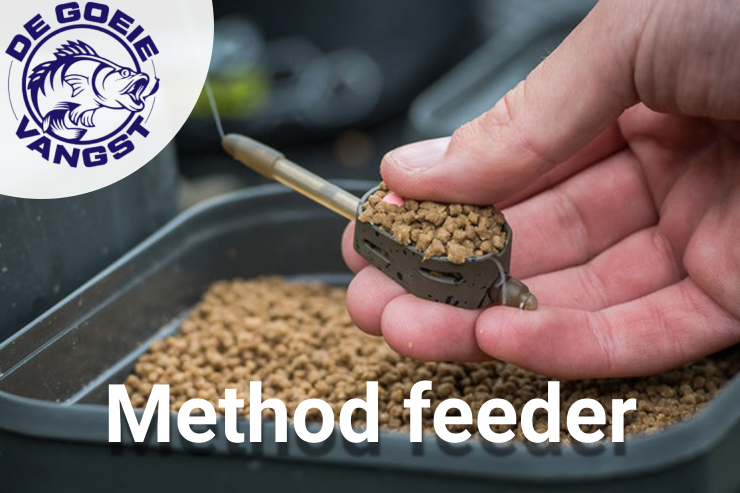Method Feeder Fishing for Beginners: What You Need to Know
Method feeding is a popular and effective method of fishing, ideal for both novice and experienced anglers. This technique offers a simple way to catch large numbers of fish, while using the right method feeder, bait and technique increases the chances of success.
Whether you are fishing for carp, bream or other whitefish, method feeding allows you to accurately get your bait in the right place and entice the fish with a carefully placed feeding spot. In this guide, you will learn everything you need to get started with method feeding. We cover the equipment needed, the right bait selection, and give you handy tips to get the most out of your fishing day.

What is method feeder fishing?
Method feeding is a fishing technique specially designed to effectively catch whitefish such as bream and carp. The principle behind method feeding is simple but powerful: you use a method feeder - a special feeding basket - to accurately present both feed and hook bait on the bottom of the water. This feeding basket holds the feed firmly while casting, and when it lands on the bottom, it slowly starts to release, making the hookbait visible to the fish.
What distinguishes method feeding from traditional feeder fishing is that the fish hook themselves. In traditional feeder fishing, you often fish with a sliding system where you have to set the hook as soon as you get a bite. With method feeding, the weight of the method feeder causes the fish to hook itself as soon as it picks up the bait. This makes it a very effective way of fishing, especially on still waters such as lakes and ponds.
Using a method feeder is also relatively simple. Once you have chosen the right spot, cast your method feeder to that location and gradually build up a feeding spot. The feed and hook bait are close together, which quickly attracts the fish. This approach makes method feeding an ideal technique for anglers looking for quick success.
THE RIGHT EQUIPMENT FOR METHOD FEEDING
Choosing the right equipment is essential to be successful with method feeding. Here is what you need to be well prepared to get started:
1. The Rod
A feeder rod is a must for method feeding. For still waters such as ponds and lakes, it is best to use a rod of 3.3 to 3.6 metres, with a casting weight of 30 to 80 grams, depending on the size of your feed basket and the feed you use. A shorter rod offers more precision and control when casting over short distances, while longer rods are suitable for larger waters and further casts.
2. The Reel
Choose a 3000- to 4000-size reel with a smooth slip. A good reel is important because the slip ensures that the fish can be controlled during the drill without the line breaking. Make sure your reel is large enough to hold a good amount of line, and has a firm slip to handle strong fish like carp.
3. The fishing line
Braided line or nylon line can both be used for method feeding, but nylon is usually recommended as it has some stretch, which is useful while drifting fish. Use line with a thickness between 0.22 mm and 0.28 mm, depending on the size of the fish and the presence of obstacles in the water. For obstacle-rich waters, you can choose a thicker line to safely steer the fish away.
4. The Method feeder
The method feeder itself is a specially designed feeding basket that helps you accurately offer both feed and hook bait. Method feeders come in different weights and sizes, depending on the conditions you fish in. A basket weighing 30 to 50 grams is ideal for most situations. Some method feeders have an elastic band in the basket, which helps absorb shocks during the drill.
5. ACCESSORIES
A landing net is essential to land the fish safely, and an unhooking mat is important to take good care of the fish while unhooking and photographing them. Use a line clip to make sure you always cast in the same spot, so you can build up a concentrated feeding spot. This will increase your chances of success.
THE RIGHT BAIT AND FEED FOR THE METHOD FEEDER
In method feeding, the bait plays a crucial role in your success. You need to choose not only the right hook bait, but also the right feed to place in the method feeder. Here are some important considerations to keep in mind:
1. Hookbait
The hook bait you use in method feeding should be eye-catching and attractive to the fish. Popular options are:
- Mini boilies: These are brightly coloured, small boilies that stand out immediately among the feed. They are especially effective for carp and bream.
- Wafters: These floating baits are balanced to float just above the bottom, making the bait easily accessible to fish. They are ideal for fishing in murky water and often have a striking colour to catch the fish's attention.
- Pellets: For a subtle presentation, you can also use pellets. These dissolve slowly in the water, attracting fish without quickly saturating them.
Make sure the hookbait contrasts with the food. A brightly coloured wafter or boilie stands out more quickly and is more likely to attract the attention of curious fish.
2. Groundbait
Groundfeed is the key to building an effective feeding spot. The bait should stick well to the method feeder so that it does not fall out of the basket during casting, but is gradually released when it is on the bottom. Popular bait options are:
- Micropellets: These small pellets are perfect for method feeders as they stick well and dissolve slowly, providing a steady stream of attraction.
- Special bait: You can also use fine bait specially formulated for method feeder fishing. This feed stays firmly on the feeder and only falls apart at the bottom, creating a feeding cloud that attracts fish.
3. ADDITIVES AND ATTRACTORS
To create extra attraction, you can add additives or liquid attractants to your feed. Liquid fish oils, such as hemp oil or salmon oil, rise in the water and attract fish from a long distance to your feeding spot. You can also use powdered additives to make your feed even more attractive
THE TECHNIQUE: HOW DO YOU FISH WITH THE METHOD FEEDER?
The method feeder technique is quite simple, but success depends on good preparation and accuracy. Below are the steps to apply method feeding effectively.
1. FEEDING AND BUILDING A FEEDING SPOT
Before you start fishing, it is important to build up a feeding spot. You do this by consistently casting in the same spot, creating a concentration of food on the bottom. This will draw the fish to your hookbait. Use the line clip on your reel to make sure you cast the same distance every time.
A useful technique is to first cast without a hookbait and only with feed in the method feeder. Do this a few times to create a good basic feeding spot. As soon as you notice fish coming to the spot, you can start fishing by adding hook baits.
2. CASTING THE METHOD FEEDER
After filling your method feeder with feed and attaching your hookbait, make the cast to the chosen feeding spot. Try to cast as accurately as possible so that you keep fishing the same spot every time. If you have properly pressed the feed onto the feeder, it will stay in place during the cast and will only start to release on the bottom.
3. KEEPING AN EYE ON THE BITE
Once your method feeder is on the bottom, tighten the line slightly and place your rod on the stand. Now the wait is for a take. Method feeder fishing is known for clear bites: the rod often bends vigorously when a fish picks up the bait. Resist the temptation to strike too early. The method feeder makes the fish hook itself as soon as it picks up the bait.
4. REGULAR feeding
To keep the fish interested and the feeding spot active, it is important to refill regularly. This means re-throwing every 5 to 10 minutes, even if you haven't had a bite. By being consistent, you create a rhythm that attracts the fish. Make sure you don't wait too long to top up, otherwise the fish may leave the feeding spot.
5. landing the fish
When you have a bite and the rod bends, you don't need to set the hook, because the fish has already hooked itself due to the weight of the method feeder. Gently lift the rod and start bringing in the fish. Make sure you have adjusted the slip on your reel properly so that the fish does not break loose during the drill. Use a landing net to land the fish safely, and make sure you place the fish on an unhooking mat to avoid damage.














